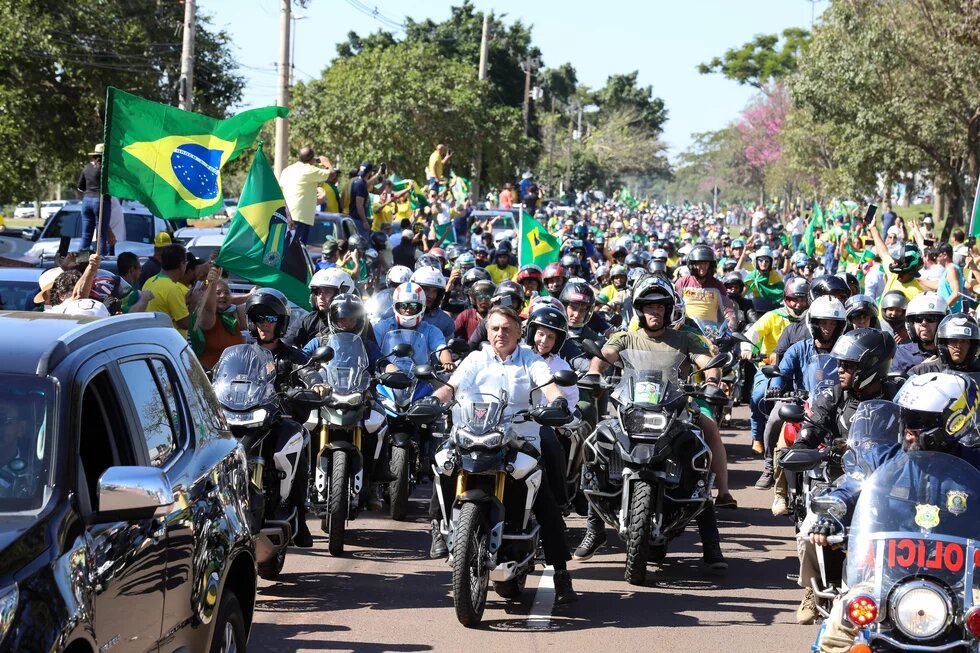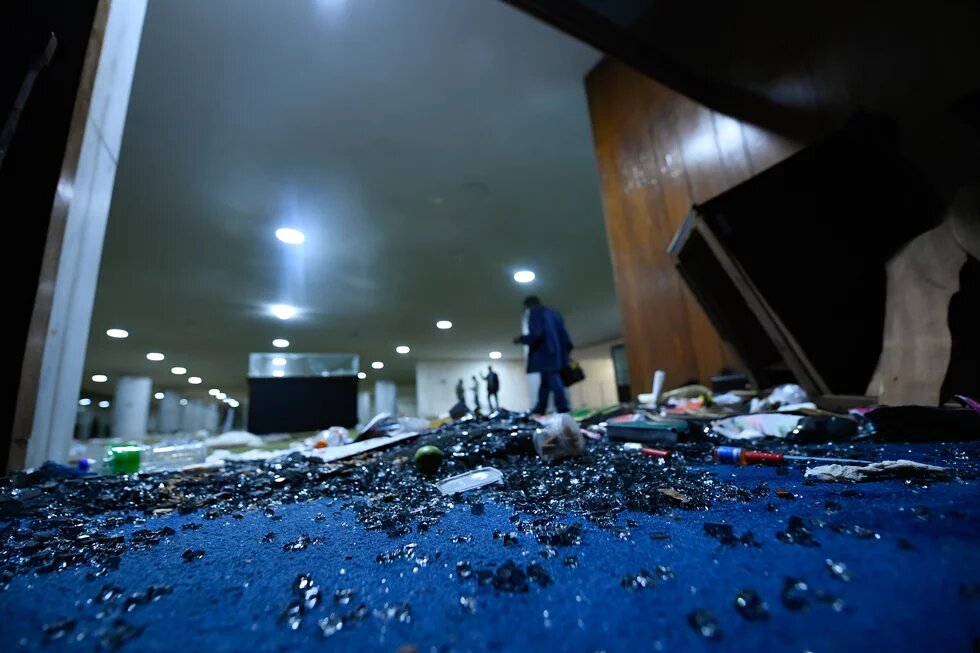
Questions remain in Brazil after former President Jair Bolsonaro's supporters stormed the federal government's buildings on January 8.

The day of January 8th, 2023, will go down in the political history of Brazil. The occupation of the Esplanade of the Ministries, the site of the three branches of power of the Brazilian Republic, followed by acts of vandalism and depredation, was an attempt at a coup d’état. Spurred by the narrative of insurrectionists and aggravated for nearly four years on social media by statements from the Bolsonaro administration and other influencers, the expectation was that once chaos had set in, the armed forces would intervene (in the pattern of the events of 1964, which brought Brazil into a dictatorship that lasted 20 years). Despite being illusory proclamations, they achieved what is generally part of the extreme right’s strategy around the world today: the creation of a narrative, a political fact, capturing media attention, acquiring more followers, and keeping the mob going.
However, the approach seems to have backfired. The acts of vandalism, the destruction of historic works of art, and the disrespect for public property and institutions have been broadly condemned by society, but have made clear to the world the size of the threat to democracy and revealed how far fascist and insurrectionist groups have advanced in Brazil. Although the responses by the new administration and the Federal Supreme Court have been vigorous and symbolic, including the detention of nearly 2,000 rioters, and joint meetings of the three powers and state governors, questions remain.
Preparing for an insurrection
The insurrection exercises began well before January 8th: from the beginning of the Bolsonaro administration, there were already demonstrations of what could happen. The celebration of September 7th—the day of the Proclamation of the Independence of Brazil—was transformed into a platform for attacks against the Federal Supreme Court (STF)and the Superior Electoral Court by then-President Bolsonaro and his supporters. There were also speeches denying the effectiveness of Covid vaccines and calling for the intervention of the armed forces. At another point, insurrectionists took over part of the Esplanade, in an encampment dubbed the “300 do Brasil” (The Brazilian 300), with public plans to close Congress and forcibly remove ministers of the STF. The demonstrations grew. During the pre-electoral period, there was a series of acts reminiscent of the symbology and aesthetics of Mussolini and Italian fascism. During his campaign for re-election, Bolsonaro held 17 motorcycle and car rallies in several cities, which recalled similar demonstrations organized by Mussolini in the 1930s. In these rallies, there was the notable participation of military officials, important participants that, in the imagination of these groups, played the role of arbitrator and “moderator” of the other powers. Their presence in these acts of President Bolsonaro (along with the invitation for a general to join the campaign as running mate) strengthened the notion that this sector would ally with the president in promoting a coup d’état.
If before the election results, coup exercises were presented as a demonstration of the power of the government in the face of alleged threats (which included all of the political spectrum opposed to the extreme right, from progressives to neoliberal conservatives), the climate upon Bolsonaro’s defeat was one of radicalization. Truck drivers blocked highways in protest of the election results, while online, the fake-news machine went into action, claiming election fraud. The silence of President Bolsonaro, never explicitly conceding the election, was considered a signal to his supporters to rise up against democratic institutions.
The number of camps in front of military barracks also began to increase, with thousands requesting “federal intervention.” The military never acted to remove those protestors, who clearly were acting against democratic order. According to investigations, the camps were financed by business leaders and by agribusiness, and were supplied with all the necessary infrastructure. Their population was mostly over 40 years of age, many of them retired military. But there were also politicians, active military and members of the police. These people represented a cross-section of Brazilian society that lives in a parallel reality, fed by conspiracy theories: a conservative, fundamentalist Christian Brazil, whose idea of family and relationships has no room for the LGBTQI+ population; is accustomed to seeing the Black population in subordinate roles; and does not tolerate having its interests challenged.
Attacking democracy, defending democracy
But what are the differences between the criminal acts of January and earlier attacks? The act began as a peaceful demonstration. However, in an analysis of the events, it can be seen that this was an action strategically planned to occupy the Esplanade and the Plaza of the Three Powers. Images show the complicity of the police was an important part of the success of the vandals and insurrectionists. In Brasília, the capital, the entity responsible for security on the Esplanade is the local police, who are the highest paid in Brazil. The Federal District’s secretary of Public Safety, Anderson Torres, who is a former minister of the Bolsonaro administration, occupied the position on January 2nd. As soon as he had taken charge, he dismissed all top security staff and traveled to Miami on January 7th, where ex-president Bolsonaro remains as of this writing. Headless, the police watched the arrival of almost 100 buses (mostly paid by entrepreneurs and agribusiness) full of the ex-president’s supporters, who then joined those who had been encamped in front of the Army barracks since the electoral defeat of Jair Bolsonaro. Meanwhile, another political actor that monitored this movement, the Armed Forces Intelligence Service, did not see the demonstration as dangerous and downplayed the risks. Consequently, once the invasion and vandalism of the insurrectionists had begun, there were no security forces present, which made protection of the area and the buildings of political institutions very difficult.
The only response to the acts was by the newly elected administration. President Lula da Silva, who took office on January 1st, declared federal intervention in the public security of the Federal District (DF). With this measure, the government took upon itself the resolution of the crisis, ensuring that security forces of the DF and the armed forces restored order, detaining those who were performing unconstitutional acts. It is apparent that opting for federal intervention contributed to a more “civil” resolution to the crisis, as there was the possibility of bringing in the military to contain the chaos.
With the removal of the insurrectionists and the arrest of more than 1,400 people involved in the acts, different political agents joined in a show of strength and unity in support of democracy. Upon an invitation from the Lula administration, there was a meeting of the presidents of each of the three branches (executive, legislative and judicial), as well as a meeting with all the state governors. Expressing support for democracy in the face of the insurrectionist acts of January 8th, these meetings served to legitimize and strengthen the newly-elected administration, and reestablish relations between the various federal entities. This development was well received by the population as well as by other sectors of society. An IPSOS survey showed that 81% of Brazilians did not support the extremist acts of January 8th, while only 18% did.
A transnational strategy?
The Brazilian “capitol invasion” seems to have features in common with the events in Washington, DC, two years ago. In both, radicalized groups of the extreme right, egged on by the losing incumbent, attacked the symbols of their respective republic. One difference is the role played by a critical figure: the armed forces. Contrary to the U.S. armed forces, whose focus is upon external threats, the Brazilian armed forces—especially the Army—have an internal function. For example, they act in the protection of national borders and in the establishment of GLO (Guarantee of Law and Order), a military function that gives the president of the republic the exclusive authority to call upon the armed forces in the event of the inability of public security forces to contain civil disturbances. GLOs have already occurred during mega-events: the World Cup and the Olympics, the papal visit in 2013, combating environmental crimes in the Amazon, and even fighting drug trafficking in the favelas of Rio de Janeiro. All of this, plus the fact that the post-dictatorship reconstruction of democracy in Brazil depended upon the exclusion of members of the military from Brazilian political posts. A certain resentment exists that has never cooled, and military training has often perpetuated the belief that the military dictatorship in the 1960s was necessary to deter communism, rather than being a simple coup d’état. A return to a key role in public affairs was the long-held desire of some Army officials. With the arrival of the Bolsonaro administration and its military vice-president—General Hamilton Mourão—this desire took real form. It is not a coincidence that in that administration, members of the military occupied around eight thousand civilian posts.
A democratic future requires work
With slightly less than one month having passed since the attempted insurrection, some questions and challenges remain for this government. The first is to reinforce unity among the various Brazilian democratic political institutions, as well as the respect for the separation of powers. As such, the guarantee of due process regarding those who attacked democracy is important, as is efficient and exemplary punishment of those who participated in or financed those attacks. It is necessary to respond democratically to the insurrectionists, placing the population and all political players on the side of democratic institutions.
In this sense, depoliticizing the armed forces has become an urgent and necessary task for the new administration. The number of military personnel occupying civilian posts is enormous and must be reviewed. It is necessary to overcome the idea of the military as a moderating power, which instead should act only within constitutional parameters. Beyond national defense, its role is to guarantee the functioning of the three branches (the Executive, the Judicial and the Legislative), rather than act against them.
Finally, it is necessary to revise the public policies of recent years and undo the dismantling of several public institutions that once acted to promote democracy and the guarantees of groups and individuals in organized civil society. The new slogan of the Brazilian government, “Unity and Reconstruction,” is symbolic of this need in this first year. Reconstructing policies, institutions and connections in Brazil and with the rest of the world will strengthen the role of democracy in Brazil and the nation’s performance in the face of global challenges. Let us put Brazil back on the path of multilateralism and the defense of justice and solidarity, for a world that preserves its natural resources and promotes cooperation and unity.
The threat of the extreme right will continue to haunt Brazilian politics in the coming months, perhaps years. The new legislature of the Brazilian Congress counts among its members some who participated in the insurrectionist acts and some who promoted them. Only by exposing the dire violations perpetrated by these groups and acting incisively against any coup d’état may we progress in our young democracy, and we must take precautions so that our future is free from repetitions of the past.
Dieser Artikel erschien zuerst hier: us.boell.org


